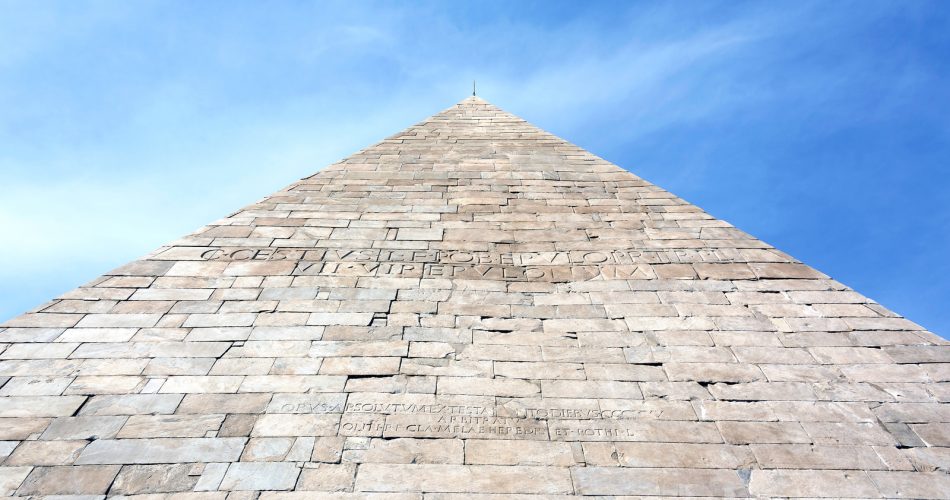The Pyramid of Cestius is one of the most unusual monuments you’ll find in Rome, standing out amidst the ruins of classical antiquity. Built between 18 and 12 BCE, it serves as the tomb of Gaius Cestius, a Roman magistrate and possibly a member of the Epulones, one of Rome’s religious colleges. While it might seem out of place in the heart of the Roman Empire, the pyramid reflects a period when Egyptomania had gripped the Roman imagination after Egypt’s annexation by Rome following Cleopatra’s death.
A Tomb with a Purpose
The Pyramid of Cestius is smaller than its Egyptian counterparts, standing about 36 meters tall and 30 meters wide at its base, yet it’s no less striking. Its construction is of brick-faced concrete, covered in gleaming white Carrara marble, which gave it a radiant appearance against the Roman landscape. This stark, sharp structure is in a city better known for its domes, arches, and columned temples, making it a true anomaly.
The pyramid was built as Cestius’ final resting place, part of the Roman tradition of lavish tombs for the wealthy. The inscription on its east side leaves little doubt about its purpose, proudly declaring that Gaius Cestius was buried inside. The inscription reads: C(aius) Cestius L(ucii) f(ilius) Pobil(ia) Epulo Pr(aetor) Tr(ibunus) Pl(ebis), which reveals his prestigious roles in Roman society.
Egyptomania in Rome
The fascination with Egyptian culture was at its peak in Rome after Augustus’ conquest of Egypt. Egypt’s mysterious pyramids, mummies, and monumental architecture captured the imagination of the Romans, who began incorporating these elements into their own culture. Cestius’ pyramid is a testament to this trend, although it differs from traditional Egyptian pyramids in several ways. For instance, it is much steeper and narrower, more similar to the Nubian pyramids in Sudan than the famous Pyramids of Giza.
Why did Cestius choose a pyramid for his tomb? We may never know the exact reason, but it’s likely that he wanted to align himself with the mystical grandeur of Egypt, creating a tomb that would ensure his name lived on in the same way as the pharaohs. The pyramid was not only a grave but also a statement of wealth, power, and influence.
The Pyramid of Castius. Image Credit: Yayimages/Pyramidomania.
Hidden Interiors
The interior of the pyramid, while inaccessible to the general public today, holds a small burial chamber measuring about 6 meters by 4 meters, with vaulted ceilings and frescoes that have faded over time. Unfortunately, the pyramid was looted in antiquity, so whatever treasures Cestius might have been buried with are long gone. Still, the chamber gives us a glimpse into Roman funerary customs and how the elite borrowed foreign elements to craft their legacy.
A Time Capsule in Modern Rome
In the centuries that followed, the Pyramid of Cestius fell into obscurity. It was incorporated into the Aurelian Walls during the 3rd century, which may have been what saved it from destruction. By becoming part of the city’s defensive structure, it was preserved as a curious relic of a bygone era. Today, the pyramid stands near the Protestant Cemetery, providing a striking contrast to the serene surroundings.
It wasn’t until the 1600s that archaeologists rediscovered the pyramid’s original purpose, and during restoration efforts, they found Cestius’ name engraved on the marble. Despite Rome’s ever-changing landscape, this 2,000-year-old pyramid remains a captivating symbol of the city’s blend of cultures, serving as both a reminder of the Roman Empire’s reach and its insatiable curiosity for the exotic.
The Mystery and Legacy
The Pyramid of Cestius may not draw the same crowds as the Colosseum or the Pantheon, but it has its own magnetic charm. It tells the story of a time when Rome was fascinated by Egypt, a cultural exchange that went both ways, from the banks of the Nile to the heart of the Roman Empire. Gaius Cestius, in choosing this Egyptian-style tomb, ensured that his name would endure, even if the details of his life remain largely unknown.
Today, visitors can admire the pyramid from the outside, where it rises starkly against the Roman sky, a piece of ancient Egypt transplanted to the Eternal City. It’s a reminder of how, even in death, the wealthy and powerful sought ways to make their mark on history—and in Cestius’ case, it worked. His pyramid still stands, a timeless testament to his ambition and the Roman obsession with all things Egyptian.
The Pyramid of Cestius is one of the more unusual ancient sites in Rome, a unique fusion of Roman and Egyptian architectural styles. While much of its history remains shrouded in mystery, its mere presence speaks volumes about the cultural currents that shaped Rome in the first century BCE. As you stand in its shadow, it’s impossible not to feel a connection to the past, to a time when Rome was at the height of its power, borrowing from the civilizations it conquered and making their customs its own.

